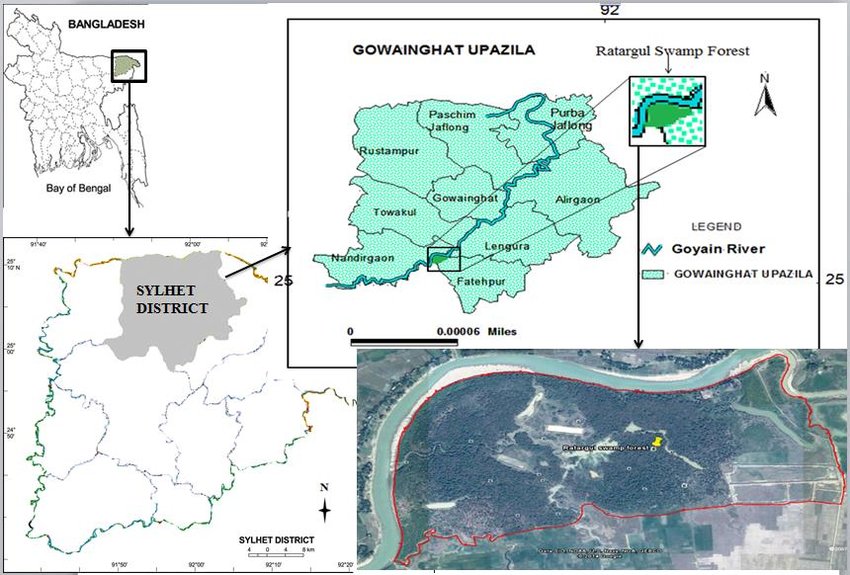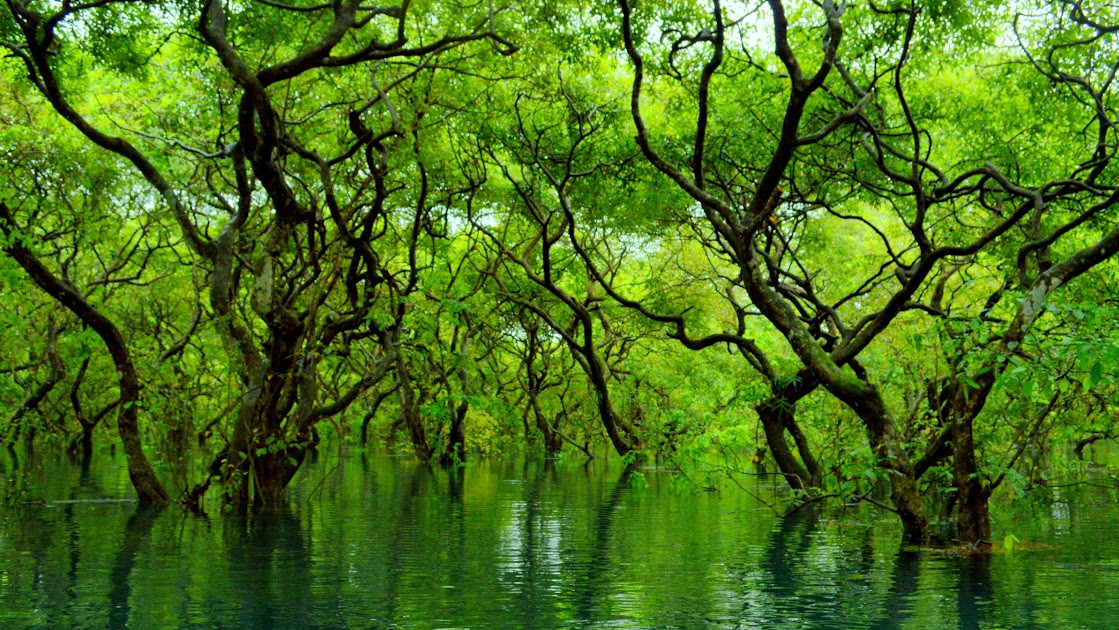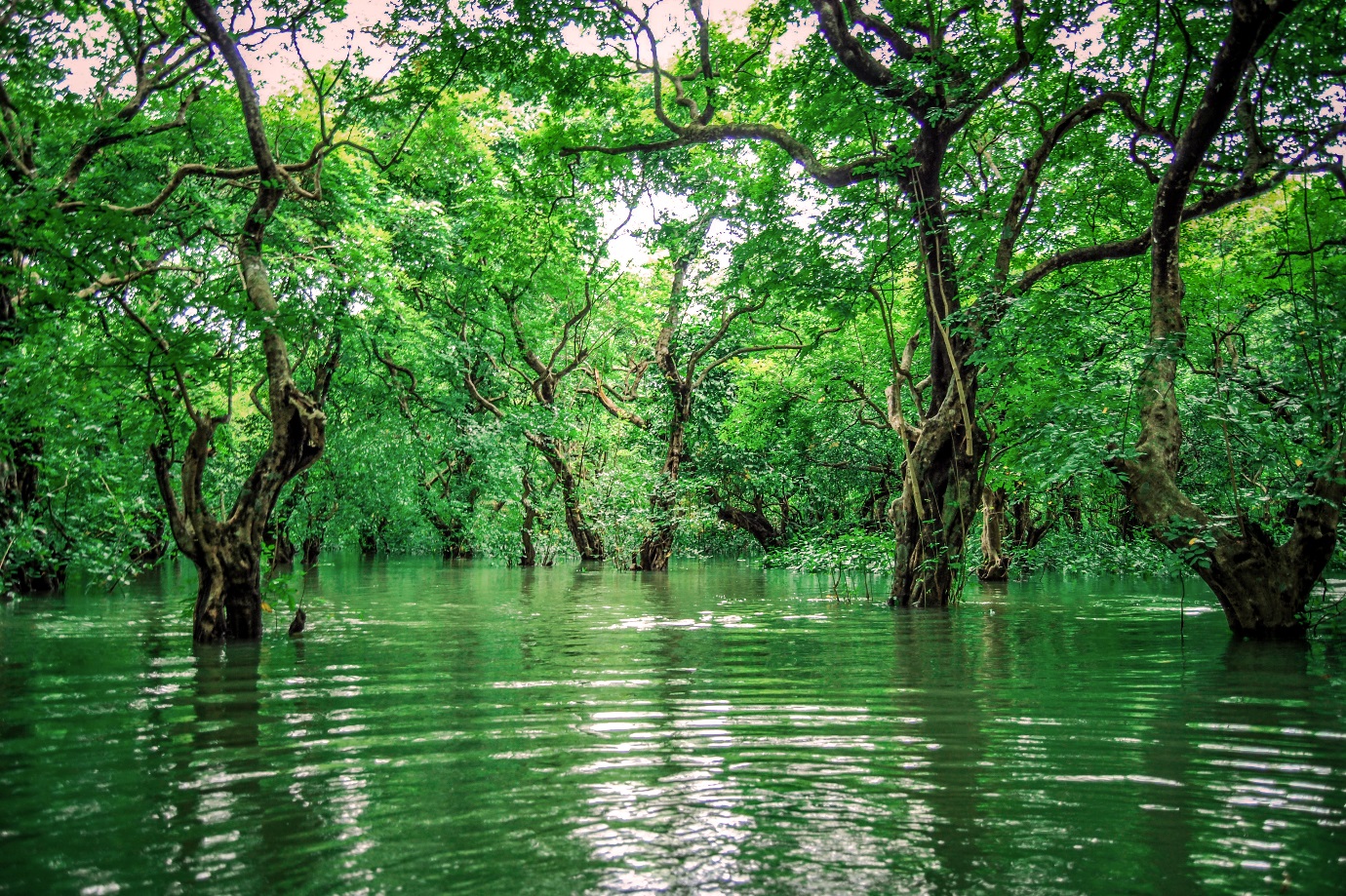Swamps
Swamp forests are found on peat-poor soils that are permanently waterlogged. They may be created and maintained by land topography (basin swamps), hydrological barriers or high water tables. Aquatic habitats in swamp forests may be sporadic, seasonal or permanent.
Types of Swamp Forest in Bangladesh
- Beach forest
- Freshwater swamp forest
- Mangrove forest or tidal forest or saline water swamp forest
Freshwater Swamp Forest
Freshwater swamp forests, or flooded forests, are forests which are inundated with freshwater, either permanently or seasonally.
Ratargul Swamp Forest is a freshwater swamp forest located in Gowain River, Fatehpur Union, Gowainghat, Sylhet, Bangladesh. Ratargul was once thought to be the only freshwater swamp forest in Bangladesh, and one of the few freshwater swamp forests in the world. Later, more swamp forests namely Jugirkandi Mayabon, Bujir Bon and Lokkhi Baor swamp forest were discovered in Bangladesh. The forest is naturally conserved under the Department of Forestry, Government of Bangladesh.
| Freshwater Swamp Forest | Location |
| Gowain River, Fatehpur Union, Gowainghat Upazila, Sylhet. |
| Alirgaon Union, Gowainghat Upazila, Sylhet in Jugirkandi Haor. |
| Jintapur and Goainghat upazilas of Sylhet. |
| Baniachong upazila of Habiganj. |
The area of Ratargul Swamp Forest is 3, 325.61 acre including 504 acre declared as the animal sanctuary in 2015. It is known as the Sundarbans of Sylhet. This only swamp forest in Bangladesh is located 26 kilometres far from Sylhet. The forest’s name comes from the word, “Rata” or “Pati” tree, used by the locals of Sylhet.

Figure 1: Location of Ratargul Swamp Forest (Islam et al., 2016)
Climate Condition of Ratargul Swamp Forest
- Tropical air from the northwest of Sylhet causes heavy rainfall. According to Sylhet Weather Centre, average annual rainfall is 4162 millimeters. July hosts the most rainfall, with measures averaging 1250 millimeters.
- December is the driest season with 74% relative density, compared to more than 90% in July and August. The forest is linked with the Gowain River through the lake Chengir Khal.
- During the rainy season, water from India overflows into the lake from the Gowain River and the forest becomes flooded. This continues through the wet season from May to early October. During this time of the year, the average high temperature hits 32° Celsius.
- In January, the coolest month, the average high sits around 12°C. During the rainy season, the trees of the swamp submerge about 10 ft (somewhere even 15-20 ft) under water but the forest emerges during the dry season.
Plant Diversity of Ratargul Swamp Forest
- 73 species of plants could be found in the forest till now. 80 percent of the forest area is covered with umbrella of the trees.
- Two layer of plants can be seen in the swamp forest. The upper layer consists of trees and the lower one consists of intense Schumannianthus dichotomus. The canopy of the plants spreads up to 15 meters of height.
- Though the forest is natural, the Forestry Department of Bangladesh has planted some watery plants like-
- Calamus tenuis, Neolamarckia cadamba, Barringtonia acutangula, Calamus tenuis.
- Banyan Tree is very common in the forest.
Besides that, Barringtonia acutangula, Dalbergia reniformis, Crateva religiosa or Hygrophila (plant), Alstonia scholaris can also be seen.
Aquatic fauna of Ratargul Swamp Forest
The ecosystem of Ratargul swamp forest is enriched with wetland plants, mammals, fauna, and reptiles. A total of 74 plant species, 9 amphibians, 20 reptiles, 26 mammals, and 175 birds (including migratory species) were recorded in the locality (Islam et al. 2016).
A total of 94 fish species were recorded in the Ratargul swamp forest. Among them 28 species are threatened, of which 14 are vulnerable, 10 are endangered and 4 are critically endangered. It is revealed that there has been gradual reduction of fish diversity in the swamp forest. Major factors affecting fish biodiversity were grouped into three categories such as manmade factors, environmental factors and policy issues (Islam et al. 2016).
Tourists Attraction of Ratargul Swamp Forest
Tourists mostly go to see the forest in monsoon. One needs to take permission from the forest office to visit the forest. A local boat needs to be hired to travel through the swamp forest. There is a building tower (watch tower) inside the forest and one can see the whole view of the forest from there.
How Ratargul Swamp Forest is Being threatened?
- Tourists have a full access to the all parts of the forest easily, they play sounds in mikes in high volume inside the forest.
- People throw packets, bottles, papers in the water which pollutes the water and is a barrier to the living of many rare fishes.
- There is a 5 storied watch tower inside the forest, here many tourists come everyday.
- The illegal encroachment of the forest have minimized its area.
- Though it is a reserved forest but the forest department are like very careless for the reservation of this swamp forest.

Figure 2: Ratargul Swamp Forest (tbsnews.net)
How can we protect Ratargul Swamp Forest?
- A proper plan should be taken into account to protect the forest.
- Government as well as many NGO’s or organizations should come forward to protect the forest.
- All the parts of the forest should not be accessible.
- There should be strict rules for the tourist who wants to visit the forest.
- Tourist visiting hours should be fixed in a daytime.
- To shout or play song in high volume inside the forest should be banned.
- Illegal encroachments should be stopped from the forest.
- Fishing area should be fixed and fishing inside the forest should be banned.

Figure: Ratargul Swamp Forest (flickr)
For more details about the biodiversity of Ratargul swamp forest follow the following references:
- Factors Affecting the Fisheries Biodiversity of Ratargul Swamp, Forest of Sylhet District, Bangladesh
- Assessment of Aquatic Faunal Diversity in the Ratargul Swamp Forest at Sylhet in Bangladesh
- Status of The Fauna of Ratargul Swamp Forest
- Ichthyofaunal Diversity of the Freshwater Swamp Forest Ratargul, Sylhet, Bangladesh
- Biodiversity of Ratargul Swamp Forest, Sylhet, IUCN Bangladesh
References:
- Afroz T, Uddin MS, Talucder MSA, Islam F (2020) Status of the fauna of Ratargul Swamp Forest. Bangladesh Journal of Ecology, 2, 7-11
- Choudhury JK, Biswas SR, Islam SM, Rahman O and Uddin SN (2004) Biodiversity of Ratargul Swamp Forest, Sylhet. IUCN Bangladesh Country Office, Dhaka, Bangladesh, iv +24 PP. ISBN No: 984-32-1996-6
- Islam MA, Islam MJ, Arefin S, Rashid A, Barman SK (2016) Factors affecting the fisheries biodiversity of Ratargul swamp forest of Sylhet district, Bangladesh. IOSR Journal of Environmental Science, Toxicology and Food Technology, 10(1), 60-65
- Islam MA, Islam MJ, Arefin S, Rashid A, Barman SK (2016) Factors affecting the fisheries biodiversity of Ratargul swamp forest of Sylhet district, Bangladesh. IOSR Journal of Environmental Science, Toxicology and Food Technology, 10(1), 60-65
- Islam MS, Islam MA, Sweety NA, Hossain MAR, Kabir MH (2016) Assessment of aquatic faunal diversity in the Ratargul swamp forest at Sylhet in Bangladesh. Journal of Environmental Science and Natural Resources, 9(2), 51-64
- Islam MS, Islam MA, Sweety NA, Hossain MAR, Kabir MH (2016) Assessment of aquatic faunal diversity in the Ratargul swamp forest at Sylhet in Bangladesh. Journal of Environmental Science and Natural Resources, 9(2), 51-64
- Jahan KM, Akhter H (2018) Impact of ecotourism on the environment, society and culture of ratargul swamp forest in sylhet, Bangladesh. Asian Journal of Environment & Ecology, 8(1), 1-8
- Jahan KM, Zakaria A (2019) Environmental movement and the conservation of forest: A case study on ratargul swamp forest of Sylhet, Bangladesh. Asian Research Journal of Arts & Social Sciences, 9(3), 1-7
- Nasren S, Talukder S, Barman PP, Mamun MAA (2022) Ichthyofaunal diversity of the freshwater swamp forest Ratargul, Sylhet, Bangladesh. Journal of Advanced Zoology, 42(1), 135-147